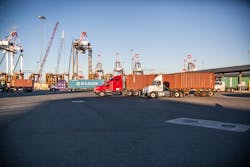Mixed signals ahead for freight market, says CarrierDirect
It’s going to be a mixed bag for the freight market over the next several months, as a sluggish U.S. economy combined with “systemic shift” in cargo away from the West Coast to the East Coast and tight truck capacity will create difficulties – as well as some positives – for shippers and transportation providers alike.
“It’s an unexciting economic forecast,” explained Erik Malin, executive VP with CarrierDirect – an advisory firm to trucking and logistics providers – in a conference call with reporters hosted by investment firm Stifel Financial Corp.
On the positive side of the economic coin, Malin said, is 3.7% gross domestic product growth in the second quarter combined with rising consumer confidence and a low unemployment rate.“The other side of that coin, though, is that industrial production capacity is now lower than in past; that does not bode well for freight,” he stressed. “The inventory-to-sales ratio is also higher than we’d like and that GDP revision up to 3.7% is largely due to higher inventory levels. That means there will be less freight move as shippers won’t need to replenish their stockpiles.”
Another reason shippers are stockpiling inventory is that they’re not confident in the availability of truck capacity. “It’s not in their favor and they don’t want to be caught unprotected,” Malin emphasized.
Jett McCandless, CarrierDirect’s founder and CEO, said this tight capacity situation is making shippers appreciate more what TL carriers “bring to table” in terms of freight service.
“But what they do not appreciate is how much costs for carriers have increased,” he pointed out. “Since 2009, the ‘large costs’ such as for equipment and driver wages have increased more than their revenues.”
In percentage figures, CarrierDirect’s slides indicated that while trucking rates are up 9% since 2009, the cost of trailer and tractors parts is up 14%, the cost of tires is up 50%, the cost of trailers has increased 18%, the cost of tractors is up 11%, and driver compensation, broadly defined, has increased 16%.
Malin stressed, however, that truck capacity will still “ebb and flow” both in the near and long term. “But the overarching theme we see is that capacity is not going to get better,” he emphasized. “Driver pay is just not where it needs to be – some say it needs to be between $60,000 and $80,000 to recruit Millennials.”
Malin also noted that the potential return of the 34-hour restart provision within hours of service (HOS) rules may reduce truck productivity again.
Also, the imposition of electronic logging devices (ELDs) by federal mandate is expected to heavily impact the owner-operator market, imposing higher operating costs while curtailing their ability to run more miles.
Another potentially unexpected truck capacity killer could be hair-based drug testing, Malin pointed out. “It is five to 10 times more accurate that urine testing for drugs, so there’s a substantial potential risk that the industry may lose more drivers,” he said. “Ultimately, then, we do not expect capacity to loosen up for at least five or more years.”
On the plus side for trucking, though, is what he calls a “systemic shift” now occurring in freight traffic away from U.S. West Coast ports to the Eastern Seaboard; a shift largely due to labor strife.
“Whether they are land or sea ports, there are positive factors in play for locations not on the West Coast,” Malin said. “[West Coast] port strikes are exposing the risk of routing freight through one port. While we won’t see abandonment of the West Coast – it is still the major and most efficient point of entry for freight from China – we will see Baltimore, Jacksonville, Miami growing capacity and throughput.”
He pointed out that ports strikes out on the West Coast earlier in 2015 significantly reduced freight volumes and thus demand for transportation. In terms of sheer numbers, January and February this year saw 200,000 fewer twenty foot equivalent units (TEUs) move through the West Coast ports, forcing Union Pacific to reduce freight train service from 60 to 30 due to it, or by 7,500 shipments.
“That was pretty sizable impact,” Malin explained. “So one of things now really relevant is gauging what ‘supply chain risk’ options shippers have. And when you look at the widening of the Panama Canal, it will boost the current limit on 5,000 TEU ships to ships that can carry 13,000 TEUs. That more than doubles the size of transport, thus meaning it will be better for shippers move to East Coast.”
About the Author
Sean Kilcarr
Editor in Chief
Sean Kilcarr is a former longtime FleetOwner senior editor who wrote for the publication from 2000 to 2018. He served as editor-in-chief from 2017 to 2018.

